
It’s been two years since I last visited the Shovel Knight franchise, and at that time I was highly impressed with Plague of Shadows, which was the first expansion on the base game, Shovel of Hope. In that one, Yacht Club Games was able to successfully build upon the lore of the series, adding depth to characters only hinted at in the first title. At the same time, Plague of Shadows completely re-imagined the gameplay mechanics of Shovel of Hope in ways befitting Plague Knight’s various idiosyncrasies. It was a risky move, but it paid off in an expansion that had strong narrative ties to the base game, while still feeling fresh and capable of standing on its own. And in that sense, the Shovel Knight series handily avoided any sort of dreaded “sophomore slump”. High expectations can be both a blessing and a curse though. Did this quirky team of clever upstarts still have tricks up their sleeve yet to be revealed in Specter of Torment?
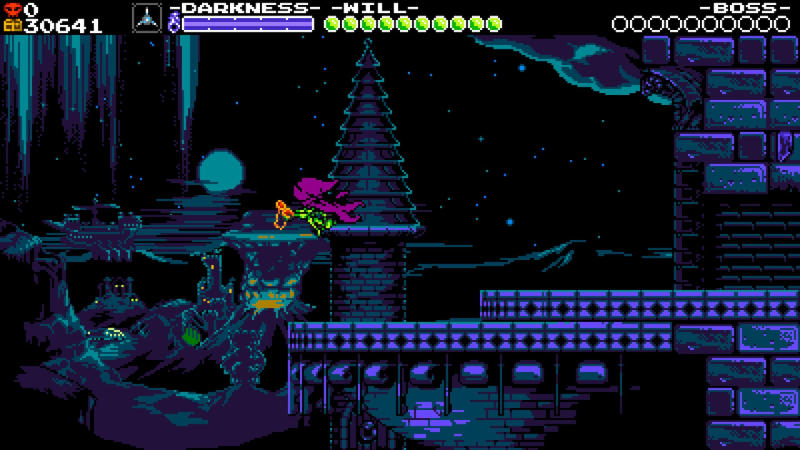
Rather than keep you in suspense, the answer to that question is, yes, 100%. Specter of Torment doesn’t pack quite the same punch as Plague of Shadows in terms of a radical re-framing, but that might sound more ominous than intended. The reason Specter of Torment doesn’t feel quite as innovative as Plague of Shadows is that Yacht Club Games has largely repeated their same trick here insofar as expanding upon the ever-deepening lore of the series while completely shaking up the gameplay (yet again). In terms of a “signature trick”, this one really requires bold confidence to pull off repeatedly though (at least with any degree of success), and you have to hand it to Yacht Club Games that they didn’t back down from the challenge.
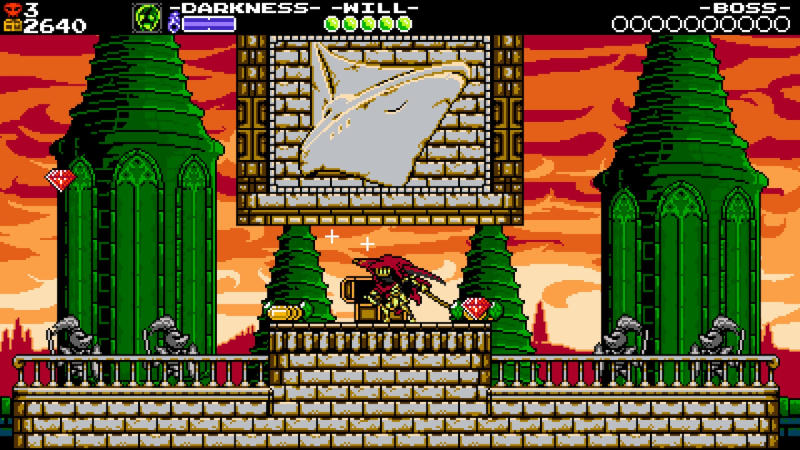
In point of fact, Specter of Torment also represents something of a departure from the general tone of the series up to this point. If we distilled Shovel of Hope and Plague of Shadows down to their base story archetypes, we’d have the story of “the erstwhile hero redeemed” and the “will-they-or-won’t-they love story”. (I’ll try to avoid spoilers, but it’s probably not terribly difficult to figure out which is which.) With Specter of Torment we find ourselves deep within narrative realms of “the tragic anti-hero”, and as such, this title is both ‘grittier’ and ‘edgier’ than either of its predecessors. This expansion is basically the answer to the (poorly formed) question of, “What if Shovel Knight, but make it emo?”. So yeah, Specter Knight is indeed a bit of a humorless, grim-dark sort of fellow, which is in stark contrast to Shovel Knight and Plague Knight, both of whom had elements of whimsy to their characters. That’s not to say that the series trademark sense of humor is missing from Specter of Torment, it’s just that the elements of humor are now carried in full by supporting characters and cast. Specter Knight is often depicted as the foil of jokes and gags, playing the de facto role of “straight-man” to the game’s many jokesters.
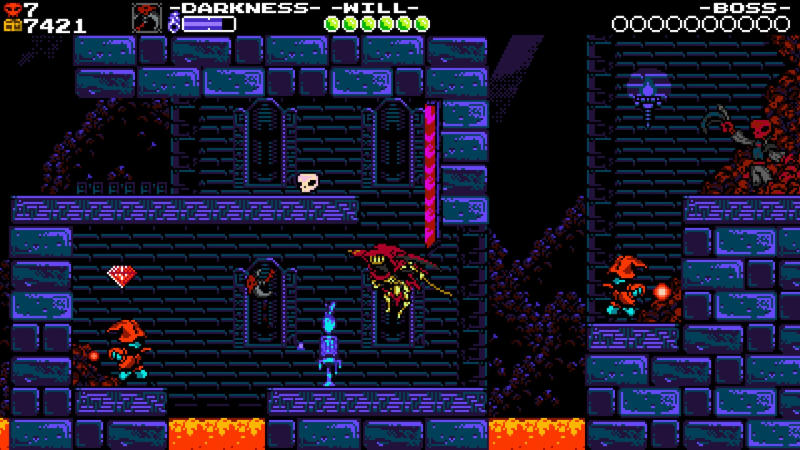
The story itself is a prequel set during the Emperess’ rise to power. Whereas Shovel of Hope included several callbacks to this era, Specter of Torment is set entirely within it. Moreover, it expands on that timeline, depicting events that pre-date anything we’ve previously seen in the series up to this point. At the direction of the Emperess, Specter Knight is tasked with assembling a devoted cadre of loyal minions, utterly compliant to the rule and whims of the Emperess. And thus begins Specter Knight’s quest to seek out the most powerful knights in the land with an offer they can’t refuse: bend the knee to the Emperess or face the blade. Obviously since this is a video game, each and every wayward knight chooses, “face my blade” before ultimately capitulating to the Empress’ demands. And this, my friends, is ultimately how the Order of No Quarter was formed. So in the end we have Specter Knight to thank/blame for the whole bloody affair. But the question then becomes … why was Specter Knight the first knight of the Empress? Was he acting out of blind loyalty … or did she have some as yet unforeseen hold over his actions? Was he possibly acting upon personal ulterior motives? These are some of the questions the game explores in detail and which are satisfactorily resolved in the denouement. It needs to be said that Yacht Club Games yet again shows a fantastic clarity of purpose in their vision for the narrative. This too is part of what defines Shovel Knight as a series: charmingly simple presentation elements which conceal a surprisingly intricate story and codex of lore.
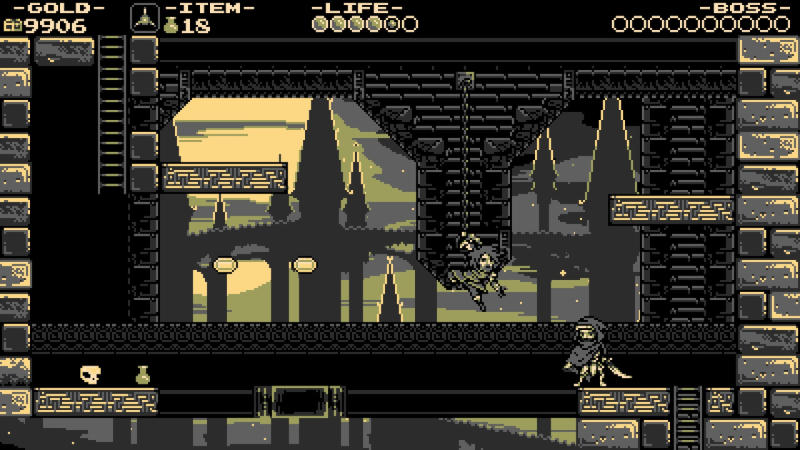
With regard to those presentation elements, we find that “charmingly simple” is an apt description as not a lot has been changed for the purposes of Specter of Torment. If this series has an Achilles heel (and I’m not necessarily saying that it does), it’s that the retro aesthetic requires that it remains frozen in time. If Shovel Knight suddenly ceased to be evocative of this very specific sort of 8-bit+ nostalgia, it would shed one of the defining characteristics of the series, and in doing so would be that much less identifiable as Shovel Knight, if that makes sense. The built-in nostalgia, in the form of graphics and sound, is part and parcel of this series, so it’s basically stuck with it. That being said, Yacht Club has always handled this aspect with an incredibly deft authorial hand, so “stuck with it” is probably not the verbiage to apply here. Far from being a lazy nostalgic cash grab, this series is (rightly) hailed as being as one of the paragons of the modern-retro aesthetic. So once again we’re treated to graphics which evoke the 8-bit era, but which are slightly better than anything that might have actually come from that era. In truth, the graphical presentation has always drifted somewhere between 8 and 16-bit quality. But nostalgia handles much of the heavy-lifting here, so as in the previous titles Specter of Torment is an effective time-machine, whisking us away to the heyday of the NES in terms of both graphics and sound. If I were to level criticism here on the basis of presentation, it would be that in Specter of Torment we’re once again visiting all the same environments we’ve seen in the previous two titles, and fighting the same bosses. Narratively this works, but … from a gameplay perspective, all these levels and bosses are starting to feel like old hat at this point. I suppose we can defer to the fact that Specter of Torment is a DLC expansion on the base game, so expecting whole heaping shovel loads of all new graphical assets and content might be asking for too much … but Specter of Torment was released as a standalone title for Switch, so … yeah. Yacht Club Games has shown time and time again that they have the chops for highly inventive, quality gameplay, so it would have been cool to see a few more all-new environments than what we see in Specter of Torment.
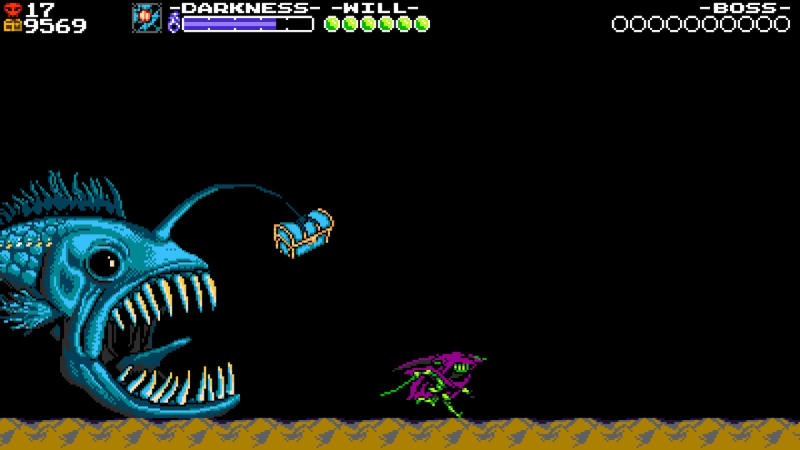
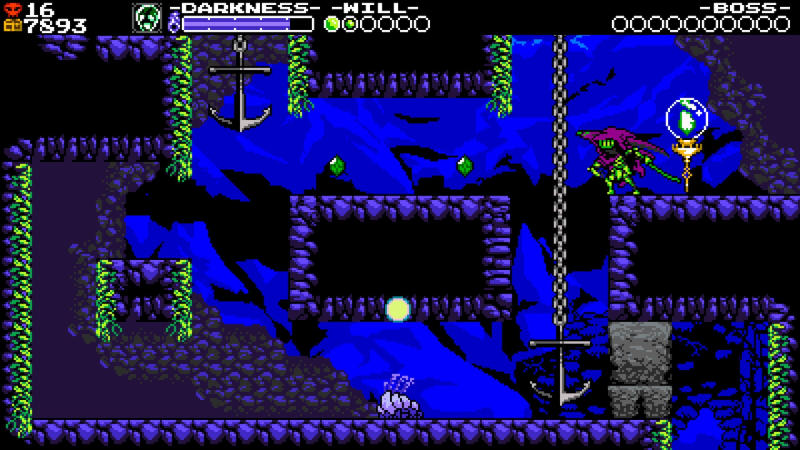
Just as in Plague of Shadows though, Yacht Club kept all the most significant changes firmly focused on the gameplay itself. Continually altering fundamental elements of gameplay across repeated iterations of a series is a strategy that tends to fail more often than not, but on this count, it’s a pitfall that Specter of Torment handily avoids. Once again Yacht Club Games has taken a previously non-playable character and really examined how they might fit into this world as a playable one. So just as we saw with Plague Knight we’re treated to all these familiar environments being reframed and reimagined in support of Specter Knight’s distinctive skill set. Much like Shovel Knight had his shovel, and Plague Knight had his arsenal of potions, almost all of Specter Knight’s mechanics revolve around the massive scythe he carries. Using his scythe, Specter Knight is able to endlessly chain jumps together so long as there are grapple points available to hook-and-zip through (or “dash slash”) with his scythe. Enemies also count as ‘grapple points’, so naturally this mechanic works equally well for stringing airborne attacks together as well. This all sounds a bit more straight forward than it actually is though. Due to the size and swing of the scythe, Specter Knight can only dash slash through those grapple points at a diagonal angle, either upwards or downwards. If you hit a grapple point from slightly below, the swing will send you upwards; hit it from slightly above, and you’ll zip downwards. So it’s completely up to player timing in order to hit the input at just the right time to determine if your trajectory will send you upwards or downwards. Especially at the onset of the game, it wasn’t uncommon that I’d launch myself directly downwards into a pit when I had meant to launch upwards and over it. So very much like Plague Knight, Specter Knight has a uniquely nuanced move set which takes some getting used to.
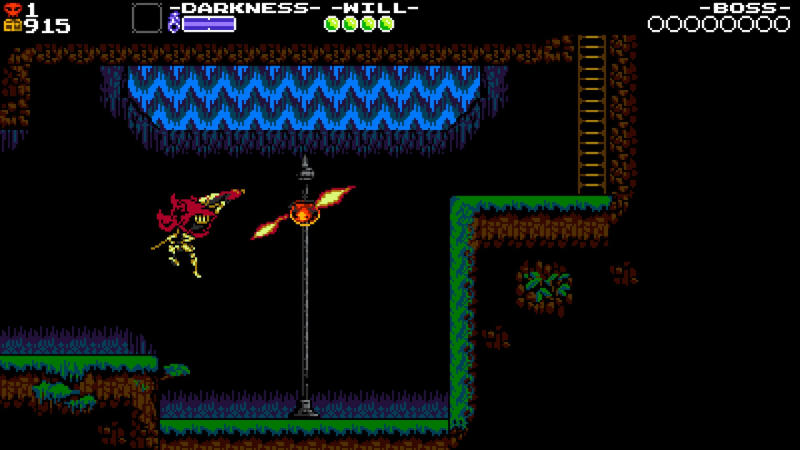
In addition to his principal scythe-based moves, you’re also able to stick to and run up walls during a very brief window. This helps out immensely in those “almost-but-not-quite” platforming scenarios, and also adds an element of forgiveness when dash slashing through grapple points towards distant landing points. Indeed, many late game areas are finely tuned to use both chained dash slashing and wall running in sequence. You can also grind rails using your scythe in much the same way that you would ride a skateboard. In the few areas you’re able to find rails in the game, you’ll automatically start a grind when you jump on to one. While grinding, you can also perform a couple of rudimentary tricks, namely a kickflip and a shove it. I won’t lie, this part felt slightly tacked on mostly due to how infrequently the opportunity arises to utilize this mechanic. I had to giggle a little bit though, being as this inclusion means that Specter Knight is both edgy and extreme! It’s the darling character traits of the 90’s all over again! Wait … he’s broody too!? By the patron saints of Cobain, Reznor and Marilyn Manson … we have the holy 90’s trifecta of personality archetypes!! Just another example of Yacht Club Games hitting that nostalgia angle (though in this case I’m not entirely certain it was intentional).
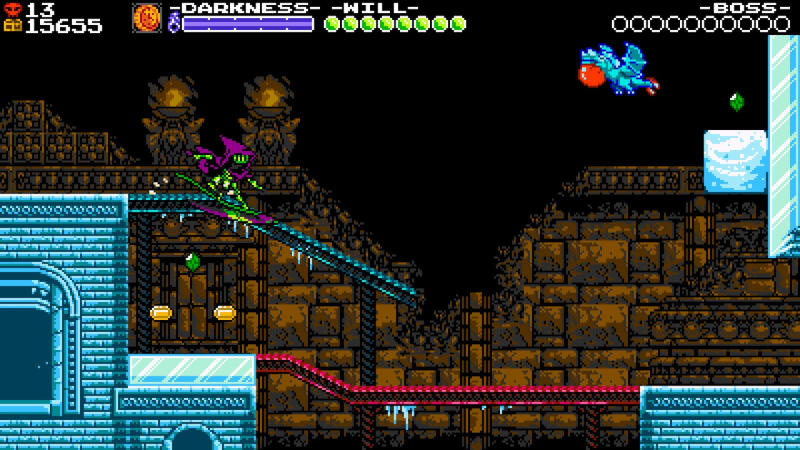
Naturally you’ll (hopefully) also find several power-ups along the way to aid you in your quest. In addition to specialty cloaks, health and magic upgrades (here labeled as ‘Will’ and ‘Darkness’ respectively), you’ll also collect Red Skulls. These can be traded for Curios, which can then be further enhanced in trade for your precious gems. It all sounds a bit more involved than it actually is. Although the names for various upgrade components have changed across the series, the system for power-ups has remained largely unchanged. Some of the more noteworthy Curios include the Green Skull which can be used for regaining health, the Dread Talon which packs a powerful close range melee strike, and the Throwing Sickle which operates like a projectile attack. You can even purchase a cloak which allows you to grind any surface at will! X-TREME!! Needless to say, these examples represent just a small sampling of all the wonderful toys you’ll come across in your adventures. It’s certainly worthwhile exploring everything in order to find what works best for your playstyle.
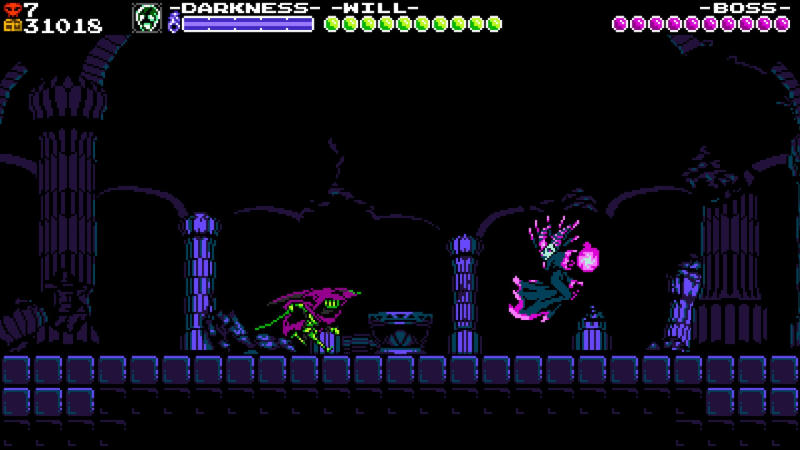
With Specter of Torment, Yacht Club Games has once again shown themselves to be a master of the modern-retro style. As of 2025 we’re practically awash in games that rely on a retro aesthetic, but it seems to me that only a few really nail that crucial element of quality retro gameplay. So while I always appreciate beautiful pixel art and well composed chiptunes, it takes a much deeper understanding of gaming history to effectively invoke the feeling which underlies so many of the legends of retro-gaming. This is the main factor that separates the Shovel Knight series from hordes of imitators, and Specter of Torment upholds that standard admirably. It doesn’t quite rise to the level of Shovel of Hope and Plague of Shadows, largely due to the re-use of in-game assets and concepts, but that doesn’t mean that the quality of the series has dipped in any significant fashion. If I’d played Specter of Torment before Plague of Shadows, I’d probably give the slight edge to Specter Knight’s adventures rather than vice versa, and for the exact same reasons. Ultimately Specter of Torment is yet another fantastic entry in an incredibly solid series. It would be very cool to see some entirely new settings and fresh ideas injected into the franchise, but it’s hard to consider that a truly egregious fault while Yacht Club Games continues to move from strength to strength in each successive entry. Recommended for 90’s broody bois and all fans of 2D platformers in general.
Final Verdict: 8 tragic anti-heroes out of 10 X Games appearances
Leave a Reply